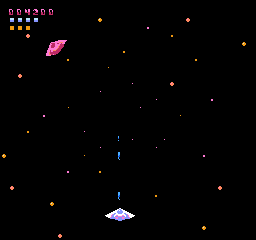Before I work on the Metal Gear-inspired stealth game and after making some basic programs for the NES, I want to get some simpler games made.
My primary semi-long term goal is Journey to Cygnus. Currently in its pre-production, infant stage, I'm developing an on-the-rails tubular space-shooter about a space pilot whose wife is captured by aliens and imprisoned in the center of the infamous supermassive black hole called Cygnus X-1. The gameplay has you, the Pilot, on a treacherous journey, flying a combat spaceship from your home planet Earth towards the distant black hole Cygnus, hence the title Journey to Cygnus. Outer space is teaming with obstacles ranging from asteroids to ice clouds to space aliens and more.
You overcome these obstacles by moving clockwise and counterclockwise on a circular rail, going "foward" through space, and using your standard Cannon Blaster and your powerful but scarce Super Blaster (ammo indicated by yellow squares below the score). Progress is measured by Warps. Much like how there are eight worlds in Super Mario Bros., there are a series of territories in outer space that the Pilot must warp through. The Pilot warps from Earth to Mars to Ceres to Jupiter to Saturn to Uranus to Pluto to the ice-filled Oort Cloud and so on into the farthest reaches of space until you reach your destination: Cygnus.
What has been roughed out for the game is up on Itch.io right now. It's currently developed in Game Maker: Studio in order to have a functioning canvas to try out new ideas with and work out game design problems before retrofitting/porting it to 6502 ASM6. To help me work through how to go about programming the 6502, I've bought Programming the 6502 by Rodnay Zaks. It is doing an excellent job of teaching what each instruction does and how it works. Once I understand that, the problem of formatting it to a NES (and preferably also MMC5 or a new, better mapper) arises. After having played through Rockman 4 Minus Infinity, I am inspired by what it is capable of doing visually and how much content it can hold in memory. The NES Dev Wiki is incredibly helpful, though the act of actually putting pen to paper is still an enigma. With determination and know-how, I know it can be done.
Upon its completion, I'd like to sell it to retro game publishers like Piko Interactive assuming their business model is reasonable.
The game takes inspiration from Gyruss, Tempest, Galaga, Rush's Cygnus X-1: Book 1 and Book 2, and the Star Wars movies.
My primary semi-long term goal is Journey to Cygnus. Currently in its pre-production, infant stage, I'm developing an on-the-rails tubular space-shooter about a space pilot whose wife is captured by aliens and imprisoned in the center of the infamous supermassive black hole called Cygnus X-1. The gameplay has you, the Pilot, on a treacherous journey, flying a combat spaceship from your home planet Earth towards the distant black hole Cygnus, hence the title Journey to Cygnus. Outer space is teaming with obstacles ranging from asteroids to ice clouds to space aliens and more.
-------------------------------------------------------------------------------------------------
.png)
Screenshot from Gyruss

Paint.Net mock-up

NES Screen Tool mock-up
-------------------------------------------------------------------------------------------------
.png)
Screenshot from Gyruss

Paint.Net mock-up

NES Screen Tool mock-up
-------------------------------------------------------------------------------------------------
You overcome these obstacles by moving clockwise and counterclockwise on a circular rail, going "foward" through space, and using your standard Cannon Blaster and your powerful but scarce Super Blaster (ammo indicated by yellow squares below the score). Progress is measured by Warps. Much like how there are eight worlds in Super Mario Bros., there are a series of territories in outer space that the Pilot must warp through. The Pilot warps from Earth to Mars to Ceres to Jupiter to Saturn to Uranus to Pluto to the ice-filled Oort Cloud and so on into the farthest reaches of space until you reach your destination: Cygnus.
What has been roughed out for the game is up on Itch.io right now. It's currently developed in Game Maker: Studio in order to have a functioning canvas to try out new ideas with and work out game design problems before retrofitting/porting it to 6502 ASM6. To help me work through how to go about programming the 6502, I've bought Programming the 6502 by Rodnay Zaks. It is doing an excellent job of teaching what each instruction does and how it works. Once I understand that, the problem of formatting it to a NES (and preferably also MMC5 or a new, better mapper) arises. After having played through Rockman 4 Minus Infinity, I am inspired by what it is capable of doing visually and how much content it can hold in memory. The NES Dev Wiki is incredibly helpful, though the act of actually putting pen to paper is still an enigma. With determination and know-how, I know it can be done.
Upon its completion, I'd like to sell it to retro game publishers like Piko Interactive assuming their business model is reasonable.
The game takes inspiration from Gyruss, Tempest, Galaga, Rush's Cygnus X-1: Book 1 and Book 2, and the Star Wars movies.
-------------------------------------------------------------------------------------------------

So freakin' cool.
-------------------------------------------------------------------------------------------------

So freakin' cool.
-------------------------------------------------------------------------------------------------